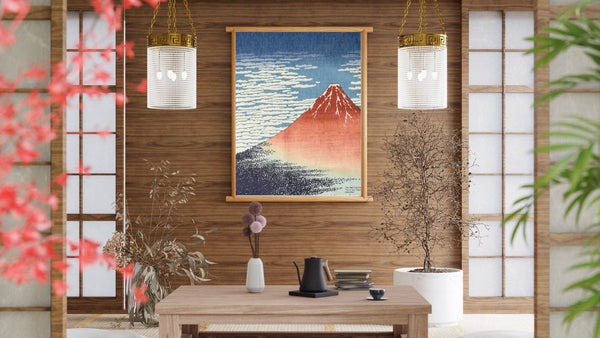
Jump to:
Japanese interior design values simplicity, balance, and nature. Guided by wabi-sabi (beauty in imperfection) and ma (appreciation of space), it favors subtle elegance and minimalism.
Everyday items like noren dividers and furoshiki cloths are both functional and beautiful. Natural materials, soft colors, and simple details create a calm, nature-inspired atmosphere.
This article explores the key concepts of Japanese décor and our 15 home decor ideas worth bringing home from Japan.
Principles of Wabi-Sabi And Ma
At the heart of Japanese interior design are two quietly profound aesthetic principles: wabi-sabi and ma.
Wabi-sabi embraces imperfection, impermanence, and understated simplicity, evident in the weathered surface of a wooden bowl, the gentle fading of indigo fabric, or the uneven weave of a handmade textile. These pieces embody a subtle grace shaped by time, inviting appreciation for their authenticity and the traces of daily life.
Ma, by contrast, is the art of spatial awareness, an understanding that emptiness holds meaning. It emerges in the stillness between objects, the gaps dividing shoji screens, and the tranquil pauses within a room’s design. By honoring space, ma allows each element to breathe, cultivating a sense of openness and calm.
Together, wabi-sabi and ma guide a design philosophy that is intentionally minimal yet emotionally resonant, an interior style deeply attuned to nature’s quiet rhythms and the poetry of everyday living, and these concepts permeate the following 15 ideas for home décor.
15 Ideas Worth Bringing Home
We’ve selected our top Japanese décor pieces worth bringing home, grouped into textiles, artisan crafts, seasonal accents, and items inspired by nature and ritual.
Textile and Fabric Décor
1. Noren Curtains
Noren are traditional Japanese fabric panels often displayed in doorways or windows, offering a harmonious blend of privacy and aesthetic appeal. Typically crafted from natural materials like cotton or linen, they showcase hand-dyed or printed designs, from seasonal patterns to iconic images such as Mt. Fuji or Hokusai’s famed wave.
Many visitors embrace them as wall art or doorway accents, infusing their homes with a subtle, authentic touch of Japanese culture.

[callout-1]
2. Furoshiki Cloths
Furoshiki, the timeless square cloths of Japan, elegantly blend function and beauty. Originally used for wrapping and carrying daily essentials, these textiles now bring character to modern interiors, as framed artwork, table accents, or sustainable gift wrap.
Crafted from natural fabrics like cotton, silk, or rayon and adorned with seasonal patterns or traditional motifs, each furoshiki carries a story of heritage and mindful living.

[callout-2]
3. Tenugui Hand Towels
Tenugui are slender, rectangular cotton cloths rooted in Japanese tradition, originally used as hand towels, headbands, and eco-conscious gift wrap. Today, they effortlessly elevate interiors as wall hangings, shelf liners, and artistic accents.
Adorned with hand-printed or dyed motifs, such as this one depicting flying carp, each Tenugui blends simplicity with style. Lightweight, affordable, and endlessly adaptable, these elegant textiles bring a quiet sophistication and a hint of Japanese heritage to any space.

[callout-3]
4. Shibori Dye Fabrics
Shibori dye fabrics are traditional Japanese textiles created using intricate resist-dyeing techniques, most commonly in deep indigo hues. Each piece is unique, with patterns formed by folding, twisting, or binding the fabric before dyeing, resulting in organic, almost painterly designs.
Shibori textiles bring texture and a sense of craftsmanship to interior spaces, whether used as cushion covers, table runners, wall hangings, or even framed art.

5. Tatami
Tatami are traditional Japanese floor mats made from woven igusa (rush grass) and a compressed rice straw or foam core, prized for their natural scent, breathability, and subtle texture. In Japanese homes, tatami define spaces for rest, tea ceremonies, or meditation, offering a soft yet supportive surface underfoot.
While full tatami flooring may not be practical for every home abroad, tatami-style yoga mat or modular mats offer a modern, portable way to introduce this timeless element. Their earthy tones and clean lines lend a calm, grounded feeling to any interior.

[callout-4]
Artisan Crafts and Collectibles
6. Kokeshi/Daruma Dolls
Kokeshi and Daruma dolls are beloved symbols of Japanese folk art, each infused with unique heritage and heartfelt symbolism. Originating from northern Japan, kokeshi dolls are handcrafted wooden figures known for their simple cylindrical form and hand-painted features. Daruma dolls, with their bold red bodies and rounded shape, embody perseverance and good fortune. Traditionally used as goal-setting talismans, they invite focus and intention into everyday life.

[callout-5]
7. Sensu Fans
Sensu, like this exquisite piece featuring the Yamani firefly design, are traditional Japanese folding fans celebrated for their graceful artistry and timeless function. Crafted from washi paper or silk and supported by slender bamboo ribs, each fan showcases hand-painted designs ranging from seasonal blossoms to serene landscapes and flowing calligraphy.
Once cherished as cooling companions or ceremonial accessories, sensu now shine as decorative elements, whether mounted on a wall, displayed on a stand, or simply admired up close.

[callout-6]
8. Lacquerware
Lacquerware is a hallmark of Japanese craftsmanship, known for its smooth, glossy finish and timeless elegance. Created by coating wood or other materials with layers of natural lacquer (urushi), each piece is meticulously polished to reveal a rich depth of color, often black, red, or gold, and sometimes decorated with gold leaf or mother-of-pearl inlay.
Used for trays, bowls, boxes, and tableware, lacquerware blends beauty with durability.

[callout-7]
Ambiance and Seasonal Accents
9. Furin Wind Chimes
Furin, or Japanese wind chimes, capture the essence of summer with their delicate tones and graceful presence. Placed by a window or on a veranda, they offer a tranquil, nostalgic ambiance.
Traditionally crafted from glass, metal, or ceramic, these charming accents sway under the eaves, where even the gentlest breeze sets them singing with a soft, cooling resonance.
Each furin is a canvas of seasonal beauty, often adorned with hand-painted motifs like shimmering goldfish, vibrant fireworks, or flowing calligraphy. Beneath, a fluttering paper strip dances with the wind, adding motion to their melody.

[callout-8]
10. Japanese Lanterns
Japanese lanterns, such as Andon and Chochin, bring a warm, ambient glow and timeless elegance to interior spaces. Traditionally made from washi paper or silk stretched over a bamboo or wooden frame, these lanterns were once used to light paths and homes before electricity.
Today, they serve as atmospheric decor, casting soft, diffused light that enhances a sense of calm. Andon are typically box-shaped and placed on the floor or table, while Chochin are round and often hung from ceilings or entryways.

11. Incense and Holders
In Japanese culture, incense is more than a fragrance; it's a ritual of reflection, tranquility, and artistry. Crafted from natural ingredients like sandalwood, aloeswood, and fragrant herbs, Japanese incense evokes the stillness of temples, the whisper of forest breezes, and the rhythm of the changing seasons.
When paired with elegant holders, be they minimalist ceramics, sculpted brass, or cast-iron works from the Nambu tekki tradition, incense transforms into a sensory experience.

[callout-9]
Nature-Inspired Ritual Items
12. Bonsai Starter Kits
More than a hobby, bonsai reflects a philosophy of patience, harmony, and mindful growth. Whether placed on a windowsill, desk, or tranquil nook, each tree evolves slowly, inviting quiet contemplation and adding a touch of organic elegance to any interior.

13. Ikebana Vases
Ikebana vases are crafted for the refined art of Japanese flower arranging, where every stem is placed with intention, reflecting balance, harmony, and seasonal awareness. Unlike Western floral styles that celebrate abundance and color, Ikebana embraces minimalism, focusing on line, space, and the quiet beauty of just a few thoughtfully selected branches or blossoms.

[callout-10]
14. Zabuton Cushions
Zabuton are traditional Japanese floor cushions used for sitting comfortably during meals, tea ceremonies, or quiet moments of rest. Typically square and filled with cotton or other natural fibers, Zabuton provides gentle support while maintaining a low, grounded seating style that aligns with Japanese interior aesthetics.

[callout-11]
15. Chawan Bowl
A chawan is a traditional Japanese tea bowl used for preparing and drinking matcha. Hasami chawan, in particular, are crafted in Hasami, a pottery town in Nagasaki with over 400 years of ceramic heritage. Known for their balanced shapes, refined glazes, and subtle textures, these bowls combine everyday functionality with timeless artistry.

[callout-12]
Embrace Simplicity, Nature, and Mindfulness at Home
Japanese home décor offers more than aesthetic appeal. It offers a way of living that values simplicity, nature, and mindfulness. From fabric accents like noren and furoshiki to handcrafted pieces such as sensu fans and zabuton cushions, each item carries cultural meaning and quiet elegance, and embodies the cultural philosophy of wabi-sabi and ma.
Do you have a favorite home décor item? Let us know in the comments.


0 comments